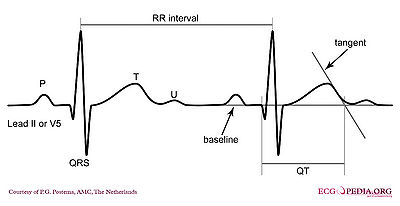الفيديوهات الطبية (موقع)
The QT interval
The
QT interval starts at the onset of the Q wave and ends where the
tangent line for the steepest part of the T wave intersects with the
baseline of the ECG.
The
eyeballing method to estimate QT prolongation. If the QT interval ends
before the imaginary boundary halfway two QRS complexes, the QTc is
probably normal. If the QTc reaches beyond the halfway line, the QTc is
probably prolonged. This method is only 'valid' in registrations with
normal (60-100/min) heart rates.
The normal QTc (corrected) interval
The QT interval indicates how fast the ventricles are repolarized, becoming ready for a new cycle.
The normal value for QTc is: below 450ms for men and below 460ms for women as agreed upon by the ACC / HRS. [2]
In a recent ACC consensus document an expert writing group
suggest that in a hospital setting the upper limit be raised to the 99th
percentile of normal: 470ms in males and 480 ms in females, as
approximately 10% to 20% of the general population have a QTc > 440m
s. For both men and women QTc > 500ms is considered highly abnormal.[3]
If QTc is < 340ms short QT syndrome can be considered.
The QT interval comprises the QRS-complex, the ST-segment, and
the T-wave. One difficultly of QT interpretation is that the QT interval
gets shorter as the heart rate increases. This problem can be solved by
correcting the QT time for heart rate using the Bazett formula: 
Thus at a heart rate of 60 bpm, the RR interval is 1 second and the QTc equals QT/1. The QTc calculator can be used to easily calculate QTc from the QT and the heart rate or RR interval.
On modern ECG machines, the QTc is given. However, the machines
are not always capable of making the correct determination of the end of
the T wave. Therefore, it is important to check the QT time manually.
Alternatives to the Bazzett correction formula are the
Fridericia, Framingham and Hodges formulas. The latter two perform
better at high heart rates (>100 /min). [4][5]
- Fridericia: QTc = QT{HR/60}1/3
- Framingham: QTc = QT + 0.154{1 – (60/HR)}
- Hodges: QTc = QT + 1.75 (heart rate - 60).
Although QT prolongation is potentially lethal, measurement of the QT
interval by physicians is not standardized, since different definitions
of the end of the T wave exist.[6]
Most QT experts define the end of the T wave as the intersection of the
steepest tangent line from the end of the T-wave with the base line of
the ECG.[7] This leads to the following stepwise approach:
| Stepwise approach to correct measurement of the QT interval |
|---|
|
During ventricular pacing this method overestimates the QTc. The
Framingham formula performs better during pacing, but still
overestimates the QTc in sinus rhythm (in the same patient) by about
37-43 msec.[8]
In a pathological prolonged QT time, it takes longer than the
normal amount of time for the myocardial cells to be ready for a new
cycle. There is a possibility that some cells are not yet repolarized,
but that a new cycle is already initiated. These cells are at risk for
uncontrolled depolarization, induction of Torsade de Pointes and subsequent Ventricular Fibrillation.
| Causes of QT prolongation |
|---|
The QT interval is prolonged in congenital long QT syndrome, but QT prolongation can also occur be acquire as a results of:
|
If the QT segment is abnormal, it can be difficult to define the end
of the T wave. Below are a number of examples that suggest how QT should
be measured in these patients.
| How to measure QT if the QT segement is abnormal | ||
|---|---|---|
The T wave is broad, but the
tangent crosses the baseline before the T wave joins the baseline. The
QT interval would be overestimated when this last definition of the end
of the T wave would be used.
|
The ECG does not meet the
baseline after the end of the T wave. Still, the crossing of the tangent
and baseline should be used for measurements.
|
A bifasic T wave. The tangent
to the 'hump' with the largest amplitude is chosen. This can change from
beat to beat, making it more important to average several measurements.
|


ليست هناك تعليقات:
إرسال تعليق